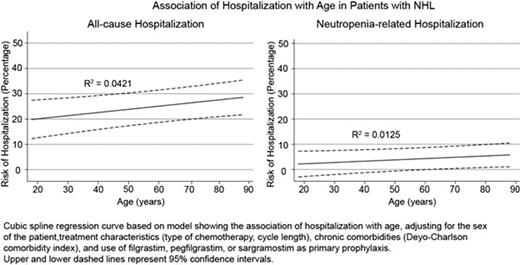Abstract
Abstract 2082
Several studies have identified older age as one of the risk factors for severe neutropenia, febrile neutropenia (FN), and related outcomes including hospitalization following myelosuppressive chemotherapy. Older age is also associated with the increased likelihood of comorbid conditions, greater severity of illness, decline in performance status, and other risk factors for complications following chemotherapy. No study has yet described the effect of age while controlling for these age-related risk factors for febrile neutropenia following chemotherapy. This analysis describes the effect of age, adjusted for patient and treatment characteristics and measurable comorbidities, on the incidence of hospitalization for any reason and also on neutropenia-related hospitalization in non-Hodgkin's lymphoma (NHL) patients receiving chemotherapy.
Using U.S. claims data from 01 January 2006 through 31 December 2009, we examined rates of all-cause hospitalization and neutropenia-related hospitalization for patients with NHL aged 18 to 89 years, during their first course of chemotherapy (when patients are at highest risk for neutropenia-related hospitalization). Neutropenia was identified in claims as ICD-9-CM code 288.0. We fitted a cubic spline regression curve based on the regression spline model that best predicted the association between hospitalization and age, adjusting for sex of the patient, treatment characteristics (type of chemotherapy, cycle length), chronic comorbidities (using the Deyo-Charlson comorbidity index), and use of filgrastim, pegfilgrastim, or sargramostim (G/GMCSF) as primary prophylaxis (defined as use within the first 5 days of the first cycle). Results are presented numerically and graphically with simultaneous 95% confidence intervals.
We identified 4,048 patients with NHL who were receiving chemotherapy. Approximately half (55%) were male; mean age was 61 years (standard deviation, 15 years) (table). The most common first cycle administration schedule was every 3 weeks (Q3W), reported for 64% of courses. Primary prophylaxis with G/GMCSF was administered in 49% of the chemotherapy courses. The risk of hospitalization for any cause was approximately 20% at age 20, rising in a nearly linear fashion to approximately 28% at age 80 (graph; R2 = 0.0421). The risk of neutropenia-related hospitalization was approximately 2% at age 20 and approximately 5% at age 80 (graph; R2 = 0.0125).
After adjusting for sex, treatment characteristics, chronic comorbidities, and use of primary prophylaxis with G/GMCSF, older age is associated with a moderate, nearly linear increase in the risk of hospitalization from any cause and a more modest but similar increase in neutropenia-related hospitalization.
Baseline Characteristics: Patients with Non-Hodgkins Lymphoma (NHL) (N = 4,048)
| Characteristic . | Value . |
|---|---|
| Male sex, n (%) | 2226 (55) |
| Age, years, mean (SD) | 61 (15) |
| Deyo-Charlson Comorbidity Index, n (%) | |
| 0–2 | 1740 (43) |
| 3–5 | 1521 (38) |
| 6–7 | 548 (14) |
| ≥8 | 239 (6) |
| First-cycle administration schedule, n (%) | |
| Every 2 weeks | 458 (11) |
| Every 3 weeks | 2599 (64) |
| Every 4 weeks | 547 (14) |
| Other* | 444 (11) |
| Characteristic . | Value . |
|---|---|
| Male sex, n (%) | 2226 (55) |
| Age, years, mean (SD) | 61 (15) |
| Deyo-Charlson Comorbidity Index, n (%) | |
| 0–2 | 1740 (43) |
| 3–5 | 1521 (38) |
| 6–7 | 548 (14) |
| ≥8 | 239 (6) |
| First-cycle administration schedule, n (%) | |
| Every 2 weeks | 458 (11) |
| Every 3 weeks | 2599 (64) |
| Every 4 weeks | 547 (14) |
| Other* | 444 (11) |
SD: Standard deviation *Other: once weekly or separated by more than 4 weeks
Deeter:Amgen Inc.: Employment, Equity Ownership. Kaye:Amgen Inc.: Consultancy. Legg:Amgen Inc.: Employment, Equity Ownership. Rothman:RTI Health Solutions: Employment.
Author notes
Asterisk with author names denotes non-ASH members.


